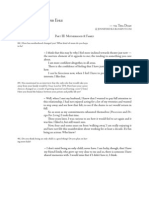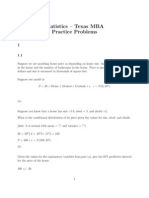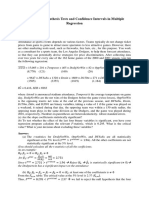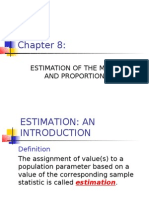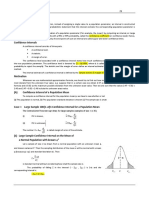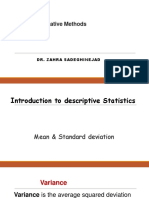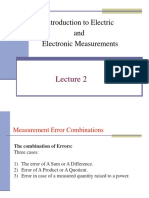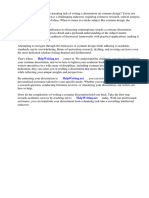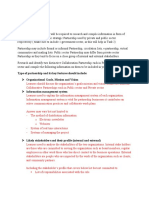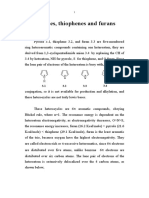BY: David J.Litja: Measurement Errors
BY: David J.Litja: Measurement Errors
Uploaded by
Ahmad Haikal Mohd HalimCopyright:
Available Formats
BY: David J.Litja: Measurement Errors
BY: David J.Litja: Measurement Errors
Uploaded by
Ahmad Haikal Mohd HalimOriginal Title
Copyright
Available Formats
Share this document
Did you find this document useful?
Is this content inappropriate?
Copyright:
Available Formats
BY: David J.Litja: Measurement Errors
BY: David J.Litja: Measurement Errors
Uploaded by
Ahmad Haikal Mohd HalimCopyright:
Available Formats
MEASUREMENT ERRORS
Copyright 2004 David J. Lilja
1
BY:
DAVID J.LITJA
Errors in Experimental Measurements
2
Sources of errors
Accuracy, precision, resolution
A mathematical model of errors
Confidence intervals
For means
For proportions
How many measurements are needed for desired
error?
Why do we need statistics?
1. Noise, noise, noise, noise, noise!
Copyright 2004 David J. Lilja
3
OK not really this type of noise
Why do we need statistics?
2. Aggregate data into
meaningful
information.
... = x
Copyright 2004 David J. Lilja
4
445 446 397 226
388 3445 188 1002
47762 432 54 12
98 345 2245 8839
77492 472 565 999
1 34 882 545 4022
827 572 597 364
What is a statistic?
Copyright 2004 David J. Lilja
5
A quantity that is computed from a sample [of
data].
Merriam-Webster
A single number used to summarize a larger
collection of values.
What are statistics?
Copyright 2004 David J. Lilja
6
A branch of mathematics dealing with the
collection, analysis, interpretation, and
presentation of masses of numerical data.
Merriam-Webster
We are most interested in analysis and
interpretation here.
Lies, damn lies, and statistics!
Goals
Copyright 2004 David J. Lilja
7
Provide intuitive conceptual background for some
standard statistical tools.
Draw meaningful conclusions in presence of noisy
measurements.
Allow you to correctly and intelligently apply techniques in
new situations.
Dont simply plug and crank from a formula.
Goals
Copyright 2004 David J. Lilja
8
Present techniques for aggregating large quantities
of data.
Obtain a big-picture view of your results.
Obtain new insights from complex measurement and
simulation results.
E.g. How does a new feature impact the overall
system?
Sources of Experimental Errors
Accuracy, precision, resolution
Copyright 2004 David J. Lilja
9
Experimental errors
Copyright 2004 David J. Lilja
10
Errors noise in measured values
Systematic errors
Result of an experimental mistake
Typically produce constant or slowly varying bias
Controlled through skill of experimenter
Examples
Temperature change causes clock drift
Forget to clear cache before timing run
Experimental errors
Copyright 2004 David J. Lilja
11
Random errors
Unpredictable, non-deterministic
Unbiased equal probability of increasing or decreasing
measured value
Result of
Limitations of measuring tool
Observer reading output of tool
Random processes within system
Typically cannot be controlled
Use statistical tools to characterize and quantify
Example: Quantization
Random error
Copyright 2004 David J. Lilja
12
Quantization error
Timer resolution
quantization error
Repeated measurements
X
Completely unpredictable
Copyright 2004 David J. Lilja
13
A Model of Errors
Error Measured
value
Probability
-E x E
+E x + E
Copyright 2004 David J. Lilja
14
A Model of Errors
Error 1 Error 2 Measured
value
Probability
-E -E x 2E
-E
+E x
+E -E x
+E +E x + 2E
Copyright 2004 David J. Lilja
15
A Model of Errors
Probability
0
0.1
0.2
0.3
0.4
0.5
0.6
x-E x x+E
Measured value
Copyright 2004 David J. Lilja
16
Probability of Obtaining a Specific Measured
Value
Copyright 2004 David J. Lilja
17
A Model of Errors
Copyright 2004 David J. Lilja
18
Pr(X=x
i
) = Pr(measure x
i
)
= number of paths from real value to x
i
Pr(X=x
i
) ~ binomial distribution
As number of error sources becomes large
n ,
Binomial Gaussian (Normal)
Thus, the bell curve
Frequency of Measuring Specific Values
Copyright 2004 David J. Lilja
19
Mean of measured values
True value
Resolution
Precision
Accuracy
Accuracy, Precision, Resolution
Copyright 2004 David J. Lilja
20
Systematic errors accuracy
How close mean of measured values is to true value
Random errors precision
Repeatability of measurements
Characteristics of tools resolution
Smallest increment between measured values
Quantifying Accuracy, Precision, Resolution
Copyright 2004 David J. Lilja
21
Accuracy
Hard to determine true accuracy
Relative to a predefined standard
E.g. definition of a second
Resolution
Dependent on tools
Precision
Quantify amount of imprecision using statistical tools
Confidence Interval for the Mean
Copyright 2004 David J. Lilja
22
c1 c2
1-
/2 /2
Normalize x
1
) (
deviation standard
mean
ts measuremen of number
/
n
1 i
2
1
= =
= =
=
=
=
n
x x
s
x x
n
n s
x x
z
i
n
i
i
Copyright 2004 David J. Lilja
23
Confidence Interval for the Mean
Normalized z follows a Students t distribution
(n-1) degrees of freedom
Area left of c
2
= 1 /2
Tabulated values for t
Copyright 2004 David J. Lilja
24
c1 c2
1-
/2 /2
Confidence Interval for the Mean
As n , normalized distribution becomes
Gaussian (normal)
Copyright 2004 David J. Lilja
25
c1 c2
1-
/2 /2
Confidence Interval for the Mean
Copyright 2004 David J. Lilja
26
o
o
o
= s s
+ =
=
1 ) Pr(
Then,
2 1
1 ; 2 / 1 2
1 ; 2 / 1 1
c x c
n
s
t x c
n
s
t x c
n
n
An Example
Experiment Measured value
1 8.0 s
2 7.0 s
3 5.0 s
4 9.0 s
5 9.5 s
6 11.3 s
7 5.2 s
8 8.5 s
Copyright 2004 David J. Lilja
27
An Example (cont.)
14 . 2 deviation standard sample
94 . 7
1
= =
= =
=
s
n
x
x
n
i
i
Copyright 2004 David J. Lilja
28
An Example (cont.)
90% CI 90% chance actual value in interval
90% CI = 0.10
1 - /2 = 0.95
n = 8 7 degrees of freedom
Copyright 2004 David J. Lilja
29
c1 c2
1-
/2 /2
90% Confidence Interval
a
n 0.90 0.95 0.975
5 1.476 2.015 2.571
6 1.440 1.943 2.447
7 1.415 1.895 2.365
1.282 1.645 1.960
4 . 9
8
) 14 . 2 ( 895 . 1
94 . 7
5 . 6
8
) 14 . 2 ( 895 . 1
94 . 7
895 . 1
95 . 0 2 / 10 . 0 1 2 / 1
2
1
7 ; 95 . 0 1 ;
= + =
= =
= =
= = =
c
c
t t
a
n a
o
Copyright 2004 David J. Lilja
30
95% Confidence Interval
a
n 0.90 0.95 0.975
5 1.476 2.015 2.571
6 1.440 1.943 2.447
7 1.415 1.895 2.365
1.282 1.645 1.960
7 . 9
8
) 14 . 2 ( 365 . 2
94 . 7
1 . 6
8
) 14 . 2 ( 365 . 2
94 . 7
365 . 2
975 . 0 2 / 10 . 0 1 2 / 1
2
1
7 ; 975 . 0 1 ;
= + =
= =
= =
= = =
c
c
t t
a
n a
o
Copyright 2004 David J. Lilja
31
What does it mean?
Copyright 2004 David J. Lilja
32
90% CI = [6.5, 9.4]
90% chance real value is between 6.5, 9.4
95% CI = [6.1, 9.7]
95% chance real value is between 6.1, 9.7
Why is interval wider when we are more confident?
Higher Confidence Wider Interval?
Copyright 2004 David J. Lilja
33
6.5
9.4
90%
6.1 9.7
95%
Key Assumption
Measurement errors are
Normally distributed.
Is this true for most
measurements on real
computer systems?
Copyright 2004 David J. Lilja
34
c1 c2
1-
/2 /2
Key Assumption
Copyright 2004 David J. Lilja
35
Saved by the Central Limit Theorem
Sum of a large number of values from any
distribution will be Normally (Gaussian)
distributed.
What is a large number?
Typically assumed to be > 6 or 7.
How many measurements?
Width of interval inversely proportional to n
Want to minimize number of measurements
Find confidence interval for mean, such that:
Pr(actual mean in interval) = (1 )
| | x e x e c c ) 1 ( , ) 1 ( ) , (
2 1
+ =
Copyright 2004 David J. Lilja
36
How many measurements?
Copyright 2004 David J. Lilja
37
2
2 / 1
2 / 1
2 / 1
2 1
) 1 ( ) , (
|
.
|
\
|
=
=
=
=
e x
s z
n
e x
n
s
z
n
s
z x
x e c c
o
o
o
How many measurements?
Copyright 2004 David J. Lilja
38
But n depends on knowing mean and standard
deviation!
Estimate s with small number of measurements
Use this s to find n needed for desired interval width
How many measurements?
Copyright 2004 David J. Lilja
39
Mean = 7.94 s
Standard deviation = 2.14 s
Want 90% confidence mean is within 7% of actual
mean.
How many measurements?
Copyright 2004 David J. Lilja
40
Mean = 7.94 s
Standard deviation = 2.14 s
Want 90% confidence mean is within 7% of actual
mean.
= 0.90
(1-/2) = 0.95
Error = 3.5%
e = 0.035
How many measurements?
9 . 212
) 94 . 7 ( 035 . 0
) 14 . 2 ( 895 . 1
2
2 / 1
=
|
|
.
|
\
|
=
|
.
|
\
|
=
e x
s z
n
o
213 measurements
90% chance true mean is within 3.5% interval
Copyright 2004 David J. Lilja
41
Proportions
Copyright 2004 David J. Lilja
42
p = Pr(success) in n trials of binomial experiment
Estimate proportion: p = m/n
m = number of successes
n = total number of trials
Proportions
Copyright 2004 David J. Lilja
43
n
p p
z p c
n
p p
z p c
) 1 (
) 1 (
2 / 1 2
2 / 1 1
+ =
o
o
Proportions
Copyright 2004 David J. Lilja
44
How much time does processor spend in OS?
Interrupt every 10 ms
Increment counters
n = number of interrupts
m = number of interrupts when PC within OS
Proportions
Copyright 2004 David J. Lilja
45
How much time does processor spend in OS?
Interrupt every 10 ms
Increment counters
n = number of interrupts
m = number of interrupts when PC within OS
Run for 1 minute
n = 6000
m = 658
Proportions
) 1176 . 0 , 1018 . 0 (
6000
) 1097 . 0 1 ( 1097 . 0
96 . 1 1097 . 0
) 1 (
) , (
2 / 1 2 1
=
n
p p
z p c c
o
95% confidence interval for proportion
So 95% certain processor spends 10.2-11.8% of its
time in OS
Copyright 2004 David J. Lilja
46
Number of measurements for proportions
Copyright 2004 David J. Lilja
47
2
2
2 / 1
2 / 1
2 / 1
) (
) 1 (
) 1 (
) 1 (
) 1 (
p e
p p z
n
n
p p
z p e
n
p p
z p p e
o
o
o
Number of measurements for proportions
Copyright 2004 David J. Lilja
48
How long to run OS experiment?
Want 95% confidence
0.5%
Number of measurements for proportions
Copyright 2004 David J. Lilja
49
How long to run OS experiment?
Want 95% confidence
0.5%
e = 0.005
p = 0.1097
Number of measurements for proportions
| |
102 , 247 , 1
) 1097 . 0 ( 005 . 0
) 1097 . 0 1 )( 1097 . 0 ( ) 960 . 1 (
) (
) 1 (
2
2
2
2
2 / 1
=
=
p e
p p z
n
o
10 ms interrupts
3.46 hours
Copyright 2004 David J. Lilja
50
Important Points
Copyright 2004 David J. Lilja
51
Use statistics to
Deal with noisy measurements
Aggregate large amounts of data
Errors in measurements are due to:
Accuracy, precision, resolution of tools
Other sources of noise
Systematic, random errors
Important Points: Model errors with bell
curve
Copyright 2004 David J. Lilja
52
True value
Precision
Mean of measured values
Resolution
Accuracy
Important Points
Copyright 2004 David J. Lilja
53
Use confidence intervals to quantify precision
Confidence intervals for
Mean of n samples
Proportions
Confidence level
Pr(actual mean within computed interval)
Compute number of measurements needed for
desired interval width
You might also like
- Apache Cassandra Administrator Associate - Exam Practice TestsFrom EverandApache Cassandra Administrator Associate - Exam Practice TestsNo ratings yet
- Outsiders Study Guide With Answers 235kaamDocument10 pagesOutsiders Study Guide With Answers 235kaamAndrés Chico Ercilla100% (1)
- Jennifer Ehle Fan Interview - Part 3-5Document6 pagesJennifer Ehle Fan Interview - Part 3-5tinattdNo ratings yet
- Understanding Errors in MeasurmentDocument130 pagesUnderstanding Errors in MeasurmentShovel_HeadNo ratings yet
- B StatisticsDocument72 pagesB StatisticsAsima NoreenNo ratings yet
- EXAM (1)Document21 pagesEXAM (1)v6gpg7kvd8No ratings yet
- 11 ASAP Basic Statistics Sampling and Sampling DistributionsSampleSize-3Document86 pages11 ASAP Basic Statistics Sampling and Sampling DistributionsSampleSize-3George MathewNo ratings yet
- Analisis Statistika: Materi 5 Inferensia Dari Contoh Besar (Inference From Large Samples)Document19 pagesAnalisis Statistika: Materi 5 Inferensia Dari Contoh Besar (Inference From Large Samples)Ma'ruf NurwantaraNo ratings yet
- Unit4_ProblemsetDocument6 pagesUnit4_Problemsetiabhimanyusingh.1No ratings yet
- Chapter 4 StatisticsDocument55 pagesChapter 4 StatisticsAlfa May BuracNo ratings yet
- Final Exam For Computer Simulation SOLUTION : Good Luck!!! Problem #1Document8 pagesFinal Exam For Computer Simulation SOLUTION : Good Luck!!! Problem #1Tsega GetnetNo ratings yet
- 227 - ch7 HW SolnDocument13 pages227 - ch7 HW SolnsonamNo ratings yet
- all ch. 9 parts practice questions KEYDocument6 pagesall ch. 9 parts practice questions KEYmaggy.mundschauNo ratings yet
- Chapter 1 - Introduction To Electrical MeasurementDocument38 pagesChapter 1 - Introduction To Electrical MeasurementAdli IkramNo ratings yet
- LDocument8 pagesLRajesh Rao B RajNo ratings yet
- CH 4 - Estimation & Hypothesis One SampleDocument139 pagesCH 4 - Estimation & Hypothesis One SampleDrake AdamNo ratings yet
- Statistics Chapter 8Document3 pagesStatistics Chapter 8api-550527993No ratings yet
- Uncertainty - Training MaterialDocument107 pagesUncertainty - Training MaterialHanan ZayedNo ratings yet
- Chapter 7-Exercises SolutionsDocument5 pagesChapter 7-Exercises SolutionslamakadbeyNo ratings yet
- 22Mitch-UncertaintiesinDosimetry 26Document53 pages22Mitch-UncertaintiesinDosimetry 26Pataki SandorNo ratings yet
- Solution For AADocument6 pagesSolution For AA208vaibhav bajajNo ratings yet
- Error Analysis - Statistics: - Accuracy and Precision - Individual Measurement UncertaintyDocument33 pagesError Analysis - Statistics: - Accuracy and Precision - Individual Measurement UncertaintyFarras Amany HusnaNo ratings yet
- Ch6 Practice STAT2263 W24 SolnsDocument5 pagesCh6 Practice STAT2263 W24 SolnselainahameedNo ratings yet
- EstimationDocument41 pagesEstimationUtkarsh SinghNo ratings yet
- 12.4 - Standard DeviationDocument12 pages12.4 - Standard DeviationMinhaj Sikander100% (1)
- MathDocument4 pagesMathVan QuibelNo ratings yet
- StudyGroup1 AnsDocument16 pagesStudyGroup1 AnsRafalel JupioNo ratings yet
- Practise Set 5 (2)Document31 pagesPractise Set 5 (2)himanshu.gidwani16No ratings yet
- Estimating Population VariancesDocument17 pagesEstimating Population VariancesRossel Jane CampilloNo ratings yet
- Week 5a - ProbabilityDocument45 pagesWeek 5a - Probability_vanitykNo ratings yet
- Statistical Data Treatment: - Part 1 (Manual Calculations)Document51 pagesStatistical Data Treatment: - Part 1 (Manual Calculations)Cess MontemayorNo ratings yet
- Chapter 2, Unites, Accuracy, and ErrorsDocument37 pagesChapter 2, Unites, Accuracy, and Errorsmahmoud zeinNo ratings yet
- CTEC233: Chemical Analysis: Handout 2-3: Statistical Analysis of DataDocument8 pagesCTEC233: Chemical Analysis: Handout 2-3: Statistical Analysis of DatajahmanNo ratings yet
- Quantitative Analysis: Dr. Basheer Ahmad SamimDocument71 pagesQuantitative Analysis: Dr. Basheer Ahmad SamimErum AnwerNo ratings yet
- IISER BiostatDocument87 pagesIISER BiostatPrithibi Bodle GacheNo ratings yet
- ch7 Statistics NotesDocument44 pagesch7 Statistics Notesdukefvr41No ratings yet
- Problems On Confidence IntervalDocument6 pagesProblems On Confidence Intervalrangoli maheshwari100% (3)
- Sample Size Calculation - PHDDocument25 pagesSample Size Calculation - PHDmohamitamunu121No ratings yet
- Tools-of-Analytical-ChemistryDocument31 pagesTools-of-Analytical-ChemistryScribdToiletNo ratings yet
- Experiment 1 - MeasurementsDocument12 pagesExperiment 1 - MeasurementsMariell AngeliNo ratings yet
- Estimation of The Mean and ProportionDocument59 pagesEstimation of The Mean and Proportion03435013877100% (1)
- Lect-1-Types and Summarizing Data - 2017Document51 pagesLect-1-Types and Summarizing Data - 2017Sara wannasNo ratings yet
- Estimating Single Population Parameters: ExercisesDocument17 pagesEstimating Single Population Parameters: ExercisesAhmad MalakNo ratings yet
- Mechanical MeasurementsDocument22 pagesMechanical MeasurementsBanamali MohantaNo ratings yet
- Statisticshomeworkhelpstatisticstutoringstatisticstutor Byonlinetutorsite 101015122333 Phpapp02Document25 pagesStatisticshomeworkhelpstatisticstutoringstatisticstutor Byonlinetutorsite 101015122333 Phpapp02Farah NoreenNo ratings yet
- Accuracy and Precision PDFDocument9 pagesAccuracy and Precision PDFrogok31402No ratings yet
- 8 Interval EstimationDocument11 pages8 Interval EstimationMugahed Abdo Al-gahdariNo ratings yet
- Example Ch101Document18 pagesExample Ch101Thảo Phương Nguyễn LêNo ratings yet
- chapter 3 (5.7.2024)Document16 pageschapter 3 (5.7.2024)John DenverNo ratings yet
- Quantitative Methods: Dr. Zahra SadeghinejadDocument38 pagesQuantitative Methods: Dr. Zahra SadeghinejadjosephNo ratings yet
- Ken Black QA ch08Document43 pagesKen Black QA ch08Rushabh Vora0% (1)
- BusDocument18 pagesBusSudip SahaNo ratings yet
- 2024 Module Test 2 - 2Document6 pages2024 Module Test 2 - 24219531No ratings yet
- Mean Median ModeDocument28 pagesMean Median ModeEs AmNo ratings yet
- Introduction To Electric and Electronic MeasurementsDocument40 pagesIntroduction To Electric and Electronic MeasurementsAliaa TarekNo ratings yet
- Statistic Sample Question IiswbmDocument15 pagesStatistic Sample Question IiswbmMudasarSNo ratings yet
- Normal Z Score and Sampling DistributionDocument36 pagesNormal Z Score and Sampling DistributionHanz ManzanillaNo ratings yet
- Final Exam: Hoang TranDocument4 pagesFinal Exam: Hoang TranHoàng Trần HuyNo ratings yet
- Confidence Interval For Variance (Problems)Document13 pagesConfidence Interval For Variance (Problems)utkucam2No ratings yet
- Two Sample T-TestDocument30 pagesTwo Sample T-Testgerwin dagumNo ratings yet
- Ken Black QA ch10Document47 pagesKen Black QA ch10Rushabh VoraNo ratings yet
- Investigation of Tensile and Flexural Properties oDocument18 pagesInvestigation of Tensile and Flexural Properties oAhmad Haikal Mohd HalimNo ratings yet
- Chapter 4 OBDocument56 pagesChapter 4 OBAhmad Haikal Mohd HalimNo ratings yet
- Hip-Total Hip ArthroplastyDocument16 pagesHip-Total Hip ArthroplastyAhmad Haikal Mohd HalimNo ratings yet
- Fluid Mechanics Lab. ENME 312: Methods of Measurement of Flow Rate of Liquids and GasesDocument10 pagesFluid Mechanics Lab. ENME 312: Methods of Measurement of Flow Rate of Liquids and GasesAhmad Haikal Mohd HalimNo ratings yet
- 022 Static Surface ForcesDocument54 pages022 Static Surface ForcesAhmad Haikal Mohd HalimNo ratings yet
- Fixture Design General Considerations: Hold Locate Support Cost vs. Benefit Fixture Required EconomicsDocument5 pagesFixture Design General Considerations: Hold Locate Support Cost vs. Benefit Fixture Required EconomicsAhmad Haikal Mohd HalimNo ratings yet
- Tech Com 3 (Article Presentation)Document9 pagesTech Com 3 (Article Presentation)Ahmad Haikal Mohd HalimNo ratings yet
- Metrology: - Mukhtar - MalikDocument78 pagesMetrology: - Mukhtar - MalikAhmad Haikal Mohd Halim100% (1)
- Simple Past Tense Dan Present Perfect TenseDocument3 pagesSimple Past Tense Dan Present Perfect TenseagusNo ratings yet
- Adiba TabassumDocument100 pagesAdiba TabassumANKIT SINGHNo ratings yet
- Communication Skills and Personality DevelopmentDocument3 pagesCommunication Skills and Personality DevelopmentNishantNo ratings yet
- A Matrix On Developing A Lesson in Reading: En4V-Iiif-38Document5 pagesA Matrix On Developing A Lesson in Reading: En4V-Iiif-38Sheryl GloriosoNo ratings yet
- Implementation of A QMS Within The MRF IndustryDocument35 pagesImplementation of A QMS Within The MRF IndustryAlexis RancesNo ratings yet
- Costume DissertationDocument8 pagesCostume DissertationBestPaperWritersSingapore100% (1)
- 2018 - HEAP - Michael - Mechanical Properties of Volcanic Rock in FranceDocument182 pages2018 - HEAP - Michael - Mechanical Properties of Volcanic Rock in FranceDhyandra NugrahanditaNo ratings yet
- Robert BoyleDocument3 pagesRobert BoyleJheamarys ArsolonNo ratings yet
- Enlg Speech Writing 1Document16 pagesEnlg Speech Writing 1aishazariya02No ratings yet
- Rivera Marcano v. Normeat-Holding, 1st Cir. (1993)Document18 pagesRivera Marcano v. Normeat-Holding, 1st Cir. (1993)Scribd Government DocsNo ratings yet
- Eye of The Tiger - Google Search PDFDocument1 pageEye of The Tiger - Google Search PDFRuchi RaiNo ratings yet
- Ijerph 14 00856Document10 pagesIjerph 14 00856anitaNo ratings yet
- Ap Music Theory - Test #1: PART I - Key SignaturesDocument2 pagesAp Music Theory - Test #1: PART I - Key SignaturesAnthony MaieseNo ratings yet
- BPI Vs FrancoDocument15 pagesBPI Vs FrancoRenceNo ratings yet
- BSBLDR803 QuestionDocument4 pagesBSBLDR803 Questiondibesh dhakalNo ratings yet
- Lab #5: How To Identify Risks, Threats & Vulnerabilities in An It Infrastructure Using Zenmap Gui (Nmap) & Nessus® ReportsDocument4 pagesLab #5: How To Identify Risks, Threats & Vulnerabilities in An It Infrastructure Using Zenmap Gui (Nmap) & Nessus® ReportsHờ Bờ Lờ100% (1)
- Educ 108 Social LiteracyDocument10 pagesEduc 108 Social LiteracyStraichea Mae TabanaoNo ratings yet
- 2 965210680489767529Document20 pages2 965210680489767529Anonymous nxfFHG32kNo ratings yet
- Practicing Wesleyan-Holiness Spiritual Formation Instructors GuideDocument328 pagesPracticing Wesleyan-Holiness Spiritual Formation Instructors GuideApril Showers100% (1)
- 2007 Annual RepandaccDocument82 pages2007 Annual Repandaccred cornerNo ratings yet
- Lubricant Characteristics: Specific GravityDocument7 pagesLubricant Characteristics: Specific GravitySande ZiyauddinNo ratings yet
- PYRROLESDocument13 pagesPYRROLESRaj BrothersNo ratings yet
- Stephen Sondheim's Gesamtkunstwerk: The Concept Musical As Wagnerian Total TheatreDocument81 pagesStephen Sondheim's Gesamtkunstwerk: The Concept Musical As Wagnerian Total TheatreDavidNo ratings yet
- Creative-Writing12 q2 Mod3Document47 pagesCreative-Writing12 q2 Mod3Princess Enrian Quintana PolinarNo ratings yet
- A Discourse On The Hemavata SuttaDocument102 pagesA Discourse On The Hemavata SuttaSabyasachi MishraNo ratings yet
- Family Law-Ii Project On Maintenance Under Hndu Law SUBMITTED TO: Professor Kahkashan Y. DanyalDocument10 pagesFamily Law-Ii Project On Maintenance Under Hndu Law SUBMITTED TO: Professor Kahkashan Y. DanyalRoopali GuptaNo ratings yet
- David D. Burns - WikipediaDocument16 pagesDavid D. Burns - WikipediacamicrisNo ratings yet
- Affidavit of David Gingras Re: Ripoff Report's Response To Lisa Borodkin's Motion For Rule 11 SanctionsDocument84 pagesAffidavit of David Gingras Re: Ripoff Report's Response To Lisa Borodkin's Motion For Rule 11 SanctionsRipoff ReportNo ratings yet


